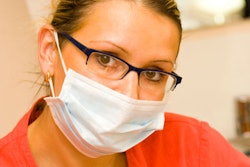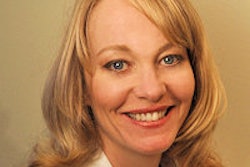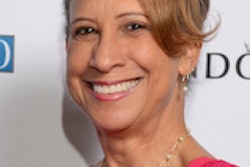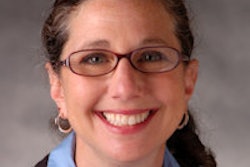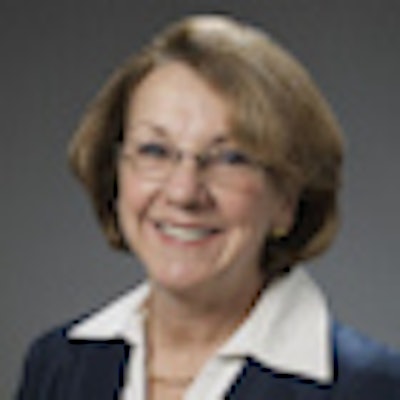
More women are needed to fill leadership positions within the ranks of the ADA and elsewhere -- especially given that female enrollment in U.S. dental schools is projected to top 50% in the "very near term," according to Kathleen O'Loughlin, DMD, executive director of the ADA.
Speaking in Denver on July 16 at the inaugural gathering of Ladies in the Loupe, a new Colorado Dental Association (CDA) discussion forum dedicated to exploring issues important to women dentists, Dr. O'Loughlin called for more proactive leadership by female dental professionals.
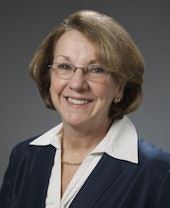 |
| Kathleen O'Loughlin, DMD, executive director of the ADA. |
"This is really serious because you are 50% of the profession, coming up," said Dr. O'Loughlin, the first female director of the ADA. "It's under-representation that will hurt us in the next 10 to 20 years."
Proof of dentistry's current gender imbalances are easy enough to see, Dr. O'Loughlin stressed. For example, the ADA House of Delegates currently has only about 155 female delegates out of 946 delegates in 17 ADA districts, she noted.
"That's not good enough," she said. "I'm encouraging every single district to represent not only our profession, but our population. We are performing woefully in terms of women and diverse minority delegates."
Such inequities threaten to discount the unique perspective women bring to the table, especially regarding issues such as work-life balance and flexible scheduling, she added. But there's more to the gender story than that: Research has shown that productivity increases when women are added to all-male executive management teams. And findings just published in the Harvard Business Review (July-August 2011, Vol. 89:7/8, pp. 68-110) suggest that human nature is more naturally attuned to collaboration within the work setting than it is to competitive spirit -- an attitude that dovetails nicely with the nurturing quality that many women dentists bring to their routines.
'You can't be a victim'
Still, perceptions regarding gender in the dental setting remain complicated. Dr. O'Loughlin cautioned that women who aspire to leadership roles need to recognize that those generations currently occupying the workforce -- Millennials (1980-1995), Generation X (1960s-1980s), and baby boomers (1946-1964) -- all have a slightly different take on the advantages and challenges of the female point of view.
“It's under-representation that will hurt us in the next 10 to 20 years.”
— Kathleen O'Loughlin, DMD
Having raised four Millennials of her own, she speaks from experience. Dr. O'Loughlin graduated summa cum laude from Tufts University School of Medicine in 1981 in a class of 165 that contained only 12 women. Eight women were enrolled in the graduating class preceding hers. The class before that one contained just two, she said.
"I faced a lot of very subtle, very humiliating, degrading prejudice as a female dental student," Dr. O'Loughlin recalled. "But you can't be a victim. That was my attitude. My attitude was to prove that I could be better than everybody else in the class, despite being a woman. By the time I graduated, I was class president and valedictorian. It wasn't because I was smarter. I just worked harder."
She entered the workforce during a recession and worked three jobs in the Boston area to pay off her school debts.
"I had a home office for 23 years because it was the only way I knew how to have kids and be a dentist," she said. As her family grew, a nanny helped out, she said.
One career advancement followed another. Dr. O'Loughlin's appointment to the helm of the ADA in 2009 acknowledged her more than 20 years of experience in private practice, 10 years in dental education, and a decade of various leadership roles in management, planning, and business operations. A partial list of her career affiliations includes organizations such as Massachusetts General Hospital, Dental Services of Massachusetts, the Oral Health Foundation of Massachusetts, and the Tufts University Department of General Dentistry.
Each stage of her journey has underscored the challenge of weighing family obligations against career responsibilities. Now, her husband of 37 years is retired and can offload some of the burdens of domestic life. And Dr. O'Loughlin is in a better position to convey some of the empirical research that has shown women dentists to be on equal footing with their male counterparts in terms of output.
25 years of data
To this end, Dr. O'Loughlin challenged her Colorado audience.
"The demands of child rearing are overwhelming, and you've got a finite period of time to do a good job with your children, right?" she said. "Have you heard over the lifespan career of a woman dentist whether they produce less, the same, or more than a male colleague?"
"More," answered one audience member.
"Less," said another.
"Depends," offered a third.
"We finally have 25 years of data, and it's beginning to look as though women peak in productivity 10 years later than men," Dr. O'Loughlin responded. "But over the career lifespan they produce almost exactly the same, in terms of number of hours treating patients. Where they lag is net income."
She especially appreciates the contributions of companies such as Grant Thornton, an accounting firm that repeatedly has supported female employees in areas such as mentoring, advancement, and work flexibility.
"They recognized that they had a shortage of women in senior management positions, and they surveyed women to find out why they feel so isolated, why they felt there was a glass ceiling, and why they felt that women could not compete on an equal basis with men," Dr. O'Loughlin said. "They acknowledged that in their organization women didn't feel welcomed."
"I hear that a lot," she said. "Maybe Colorado is different, but when I go to other ADA districts and I ask women, 'Why don't you get involved?' they'll tell me: 'I went to a district meeting and I didn't feel welcomed.' "
It may be that discussion forums like the one in Denver can help vet gender-specific issues and knock down some of those barriers. According to Jeanne Nicoulin, director of membership for the CDA, female membership in the CDA has risen to 27%. With that large a portion of the CDA previously unrepresented but now exercising a voice through meetings such as Ladies in the Loupe, a new venue for increased understanding between male and female dental colleagues has opened up.
"The grassroots impact of what you're doing cannot be understated," Dr. O'Loughlin said.




